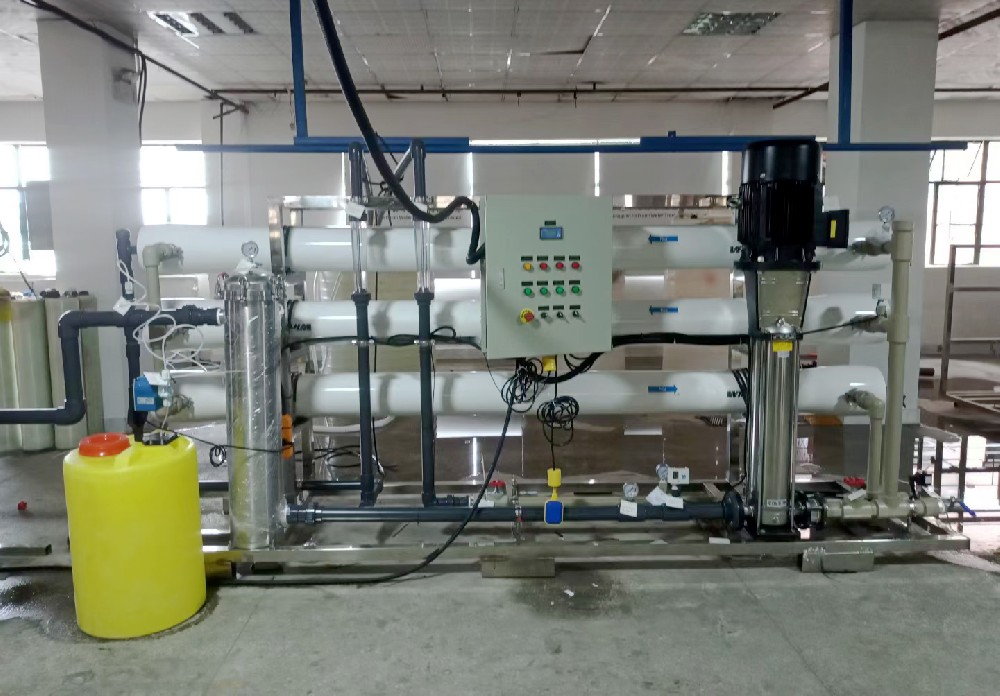
Wechat/Whatsapp:
+8613798883773

Wechat/Whatsapp:
+8613798883773
HYWATER Reverse Osmosis plant/system


Common problems of Reverse osmosis equipment operation About the removal ability of reverse osmosis equipment 1. Organic substances are easier to separate than inorganic substances; electrolytes are easier to separate than non-electrolytes; for non-electrolytes, the larger the molecule, the easier it is to remove; the removal rate of inorganic ions is related to the radius of hydrate and hydrated ions; the radius of hydrated ions The larger it is, the easier it is to remove. 2. The sodium salt of organic matter has good separation performance, while phenol and its derivatives show negative separation. For aqueous solutions of polar or nonpolar, dissociated or nondissociated organic solutes, when they are separated by a membrane, the interaction between the solute, solvent, and membrane determines the selective permeability of the membrane. These effects include electrostatic forces, hydrogen bonding, hydrophobicity, and electron transfer. 3. Typically, solutes have little effect on the physical or transport properties of the membrane. In aqueous solution, only phenols or some low molecular weight organic compounds can swell cellulose acetate. The presence of these components generally reduces the water flux of the membrane, sometimes significantly. 4. The removal effect of nitrate, perchlorate, cyanide and thiocyanate is not as good as that of chloride, and the removal effect of ammonium salt is not as good as that of sodium salt. 5. Most of the components with a relative molecular weight greater than 150 can be removed well, whether it is an electrolyte or a non-electrolyte. In addition, reverse osmosis membranes have different separation sequences for aromatics, naphthenes, alkanes, and sodium chloride. 6. During the design and operation of the reverse osmosis system, there are many mutually restrictive tasks. Therefore, under the premise of theoretical guidance, it is very important to carry out experimental verification, master the characteristics or laws of substances, and use reverse osmosis technology correctly. How to prevent scaling of reverse osmosis equipment 1. After fouling occurs in the reverse osmosis system, it usually manifests as a decrease in permeate flow, a decrease in desalination rate, an increase in operating pressure, and an increase in stage pressure difference. Fouling usually first occurs in the terminal membrane elements of the end stage, and then gradually spreads to the front. Raw waters containing calcium, bicarbonate, or sulfate may foul the membrane system within hours, and scales containing barium and fluorine generally form slower because they typically have lower raw water concentrations. 2. By dismantling the last membrane element, scales can usually be observed on the end face of the membrane element, the end plate of the membrane shell, etc., and weigh the membrane element after water control, and the weight of the membrane element will increase significantly compared with the new membrane (The weight of new membrane elements is generally around 13.5KG). 3. Dissect the terminal end-branch membrane element and analyze the scale on the membrane surface. The crystal structure of the sediment can also be observed under a microscope, and the scale type and scale material can be identified through chemical analysis or X-ray analysis. 4. It is necessary to take targeted and effective prevention and control measures according to different types of water sources. Common prevention and control measures include pretreatment, adding acid to adjust pH, adding scale inhibitors, pretreatment to remove or reduce insoluble salts (such as Resin softening and hard removal, chemical softening and hard removal, silicon removal, iron and manganese removal, etc.). How to maintain reverse osmosis equipment 1. During daily operation, the operation ledger should be recorded in detail, the instruments should be calibrated regularly, and the output of the metering pump should be checked and calibrated. 2. Each team patrols and checks the liquid level of the antiscalant tank to ensure normal dosing, and calculates the dosing concentration according to the treated water volume. 3. Do a good job in data monitoring and organize preventive cleaning on a regular basis. 4. When abnormal data is found, shut down in time, investigate the cause, and organize targeted chemical cleaning. 5. When adjusting the operating conditions of the reverse osmosis system (especially when adjusting the permeate and recovery parameters), it is necessary to first confirm the feasibility of the adjustment, and adjust the dosing amount of the antiscalant accordingly. More inquiries related to Reverse osmosis equipment please contact: Mob& Wechat& WhatsApp: (+86)13544774483 Email: sales010@water-sy.com We will provide high-quality, all-round comprehensive professional services for project consulting, system design, manufacturing, installation and commissioning, personnel training, etc
